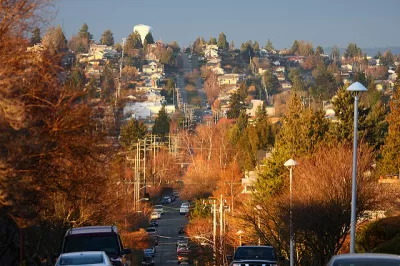"[P]erhaps at this point, this column should include a trigger warning for any young couple traumatized by the current housing market around here."

Gene Balk writes a column about the changes in the Seattle real estate market in terms of what money can buy.
This is not a happy story for many professional, middle-class residents of the city. "It’s hard to believe there was a time, and not really that long ago, when journalists — or teachers, or nurses — could go house hunting in the city of Seattle and actually buy something," writes Balk.
Even adjusting for inflation, the prices of homes in the final decades of the 20th century were far more attainable. For instance, "Census data shows that the median home value in King County in 1980 was $71,400, which, in today’s dollars, is about $225,000. That’s well below half of what it is now," reports Balk.
Balk's presentation of this information is underwritten by the implications of generational conflict. "How much less did boomers pay for their Seattle homes?" asks one of the infographics in the story (and the headline, for that matter).
To even the scales a little, Balk offers a few data points in defense of baby boomers:
…for a lot of folks back then, it didn’t seem so cheap. Keep in mind that King County home values in 1980 were about 50% higher than the U.S. median.
Another mitigating factor: Mortgage interest rates were much higher in the past, particularly in the early 1980s, when they peaked at around 16%. They didn’t fall back down into the single digits until the early 1990s.
There have always been members of the middle class cut out of the homeownership market, according to the implication of that data. Still, Balk expresses sympathy for the many among that number in 2019.
FULL STORY: How much easier was it for baby boomers to buy a home in Seattle? Let’s adjust for inflation

Study: Maui’s Plan to Convert Vacation Rentals to Long-Term Housing Could Cause Nearly $1 Billion Economic Loss
The plan would reduce visitor accommodation by 25,% resulting in 1,900 jobs lost.

North Texas Transit Leaders Tout Benefits of TOD for Growing Region
At a summit focused on transit-oriented development, policymakers discussed how North Texas’ expanded light rail system can serve as a tool for economic growth.

Why Should We Subsidize Public Transportation?
Many public transit agencies face financial stress due to rising costs, declining fare revenue, and declining subsidies. Transit advocates must provide a strong business case for increasing public transit funding.

A Visual Celebration of Manhattan’s Chinatown Elder Community, Through Food
Lanterns, cafeteria trays, and community connection take center stage in this stunning photo essay.

How to Make US Trains Faster
Changes to boarding platforms and a switch to electric trains could improve U.S. passenger rail service without the added cost of high-speed rail.

Columbia’s Revitalized ‘Loop’ Is a Hub for Local Entrepreneurs
A focus on small businesses is helping a commercial corridor in Columbia, Missouri thrive.
Urban Design for Planners 1: Software Tools
This six-course series explores essential urban design concepts using open source software and equips planners with the tools they need to participate fully in the urban design process.
Planning for Universal Design
Learn the tools for implementing Universal Design in planning regulations.
City of Santa Clarita
Ascent Environmental
Institute for Housing and Urban Development Studies (IHS)
City of Grandview
Harvard GSD Executive Education
Toledo-Lucas County Plan Commissions
Salt Lake City
NYU Wagner Graduate School of Public Service





























